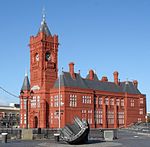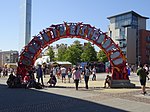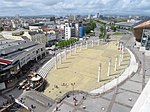Tŷ Hywel

Tŷ Hywel (Hywel House or Hywel's House) is a building in Cardiff, Wales, used by the Senedd (Welsh Parliament; Welsh: Senedd Cymru; formerly the National Assembly for Wales). It is named after the medieval king Hywel Dda (Howell the Good), King of Deheubarth in South West Wales. The building was previously known as Crickhowell House (Welsh: Tŷ Crughywel), after the former Secretary of State for Wales, Lord Crickhowell. It houses Members of the Senedd and their staff, as well as staff of the Senedd Commission. The Welsh Government also operates from the building and occupies one whole floor and part of another. It is leased by the Senedd under the Government of Wales Act 1998.The building was opened in 1991 and has a total floor area of 11,583 m2 (124,680 sq ft). It is built of red brick and is connected to the Senedd debating chamber in Cardiff Bay. Tŷ Hywel houses staff of the Senedd Commission, MSs, the First Minister and other ministers. Crickhowell House was used as a temporary debating chamber for the National Assembly for Wales from 1999 until its new building, also originally known as the Senedd, was opened in 2006. On 25 June 2008 the Prince of Wales officially opened Siambr Hywel, the National Assembly's youth debating chamber and education centre, based on the former debating chamber in Tŷ Hywel.Tŷ Hywel is part of the Senedd estate in Cardiff Bay, along with the Senedd building and the Grade 1 listed Pierhead Building in Cardiff Bay. Two covered link bridges connect the Senedd building to Tŷ Hywel. Construction of the link bridges began in September 2004 and they were completed by December 2005.
Excerpt from the Wikipedia article Tŷ Hywel (License: CC BY-SA 3.0, Authors, Images).Tŷ Hywel
Harbour Drive, Cardiff Butetown
Geographical coordinates (GPS) Address Nearby Places Show on map
Geographical coordinates (GPS)
| Latitude | Longitude |
|---|---|
| N 51.46343 ° | E -3.16237 ° |
Address
The Meeting Place on the Plinth
Harbour Drive
CF99 1NA Cardiff, Butetown
Wales, United Kingdom
Open on Google Maps









